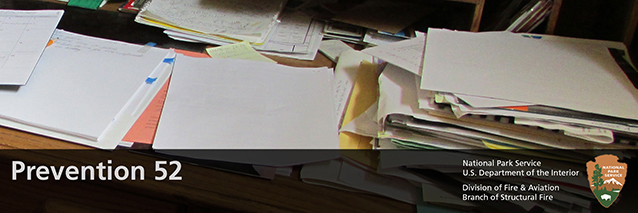Did you know that you can help prevent fires in your workplace just by reducing clutter? Find out what else you can do...

Does your coworker have piles and piles papers on or near the desk? Is the emergency exit blocked by a new shipment of brochures? Are the props for the interpretive program obstructing the fire sprinklers? Are flammable liquids stored in the furnace room?
While we all hope that our workplaces, wherever they may be, are fire safe, we can probably think of some similar scenarios to the ones mentioned above. Instead of waiting for another employee to take action, thinking "that's not my job," take control of what you can to contribute to a fire-safe workplace.
- Good housekeeping is key. Keep your workplace clean and clutter-free. An untidy work environment provides fuel for a fire and blocks access to emergency exits, fire sprinklers, fire extinguishers, and other fire safety equipment.
- Prevent arson fires by locking park buildings at the end of the day. Don't leave garbage outside of the building where it can be set on fire. Report suspicious activity near your workplace.
- Report overloaded outlets, faulty wiring, and permanent use of extension cords to your park safety officer. Check electrical appliances, such as coffee pots, toasters, portable heaters, and microwaves, regularly for these hazards. Do not hide wiring under carpets.
- Ensure appliances such as coffee pots and space heaters are turned off when you leave the office.
- Store chemicals and flammable fuels properly. This is imperative if handling and storing these items are part of your job. Contact your regional structural fire manager for clear directions and requirements. Check containers regularly for leaks and damage.
- Ensure that the electrical control panels in your building are accessible, in case the power needs to be turned off in an emergency.
- Smoke in designated areas only and dispose of extinguished smoking materials in proper containers.
- Post emergency telephone numbers and your building's address near the phones for easy reference in an emergency.
- Report fire and life safety hazards, such as missing or broken safety equipment, burned out exit lights, or faulty fire doors. Keep fire doors and locked doors closed and keep stairways and exit paths clear.
- Keep combustibles, such as garbage and paper files, out of furnace rooms, electrical rooms, or boiler rooms.
- Follow proper procedures and handle compressed gas cylinders carefully. Contact your park structural fire coordinator, safety officer, or structural fire manager if you need detailed information. Store cylinders away from heat.
Take control of what you can to prevent fires; report any suspected fire hazards to your supervisor, the park safety officer, or the park structural fire coordinator for correction. Your employer and your coworkers are counting on you to be fire-safe.
The health and safety of our visitors and employees is our highest priority. The effects of fire in our homes and workplaces go beyond the obvious risk to life safety. Some of these impacts can take years to overcome, others may be permanent. Fire can deeply impact us through the loss of irreplaceable cultural resources, disruption of visitor services, damage to critical systems, loss of a workplace and the things we need to do our jobs, and the monetary and operational impacts we bear while recovering from fire loss
Fire Info for You
Employees
Prevention is key, but preparedness for a fire event is just as important. Become familiar with your building's emergency plan and your role in it, learn how to operate a fire extinguisher, and familiarize yourself with your building's fire and life safety systems, such as smoke detectors, pull alarm locations, exit doors and stairwells, fire doors, sprinklers, fire extinguishers, and the park's fire alarm monitoring service.
If a fire event occurs, remember the acronym RACER:
- R - Rescue people from the immediate area of fire or smoke; basically, tell visitors and employees that the alarm is real and they need to exit the building.
- A - Activate the nearest fire alarm.
- C - Contain the fire on your way out of the building by closing doors behind you.
- E - Extinguish the fire, if it is small enough. Keep your escape route in view, in case the fire increases in size and you need to escape.
- R - Relocate to a predesignated outside assembly area. Supervisors must take attendance to ensure all employees have exited the building.
Have a plan for assisting with the evacuation of employees with disabilities.
Firefighters
Prepare pre-incident plans and conduct drills regularly. Familiarize yourself with each building's layout and potential problem areas, such as untidy offices, spaces with excessive fuel loads, and exits that are notoriously blocked.
Park Structural Fire Coordinators
While performing building inspections, keep your eyes out for potential problems, such as those listed above. Work with the park safety officer, supervisors, and other members of park management to correct the problems as quickly as possible.
Park Leadership
Ensure every employee is familiar with park emergency procedures. Schedule regular fire drills so everyone becomes familiar with their role in an emergency. How will all the visitors in the visitor center be evacuated in an orderly fashion? How will you help evacuate employees and visitors with disabilities?
Take Action
Treat every fire alarm as an actual emergency, even if the cause of the alarm is unknown. Fire drills are just as important as a real fire event.
Last updated: September 4, 2024
